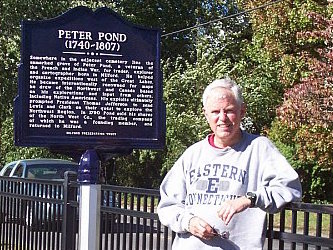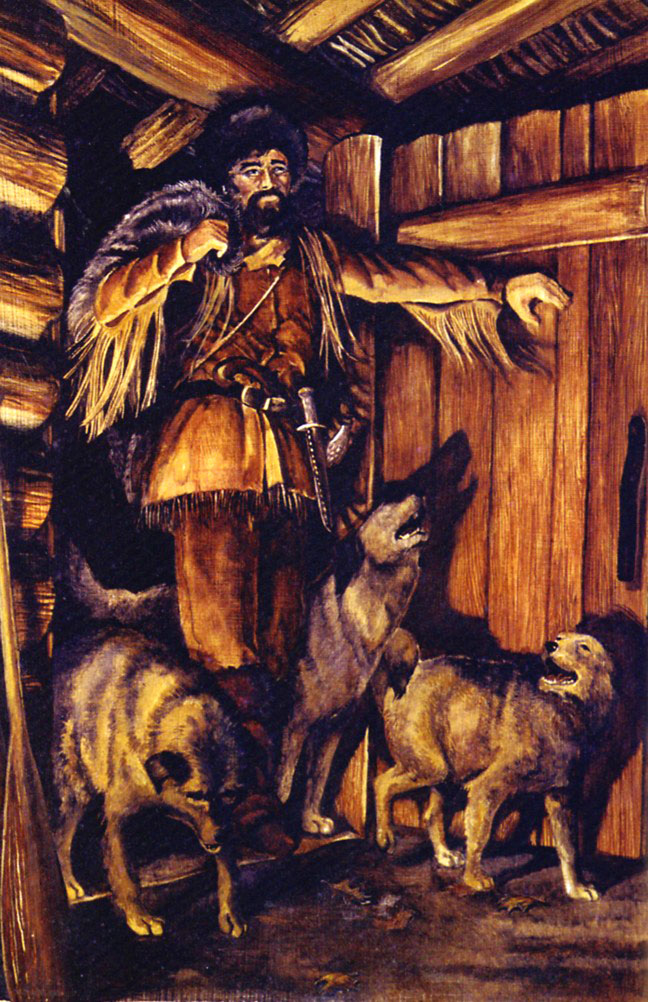Peter Pond newsletter :: January 2002 :: #11
FUSS AND O'NEILL REPORT
The formal report from Fuss and O'Neill just arrived on their pro bono ground-penetrating radar survey to search for Peter Pond's grave, and I'd like to share it with you, technical jargon notwithstanding.
As you will see below, it's not very long and although not conclusive, still somewhat encouraging in that we come away knowing more than we did before, as mentioned in Peter Pond Society 10. My theory has always been that since Peter Pond died in poverty after squandering his fur trade riches, so he could not afford a proper headstone. Since it is documented he died in Milford in 1807, he is probably buried near his mother, Mary's, headstone. The report mentions "disturbed soils" just south of Mary's headstone. Don Wilson, the F and O man who conducted the survey Oct. 25, said it looked like enough room for two graves besides Mary's, and the report concurs. So the best deduction is that those two unmarked graves are of people most likely related to Mary, one of which may be her oldest son, Peter. But she did have eight children. Her husband was also named Peter, and there's no marker for him. So let it rest for now. As the report says: "There is no way to determine the exact nature of the disturbed areas without other investigative methods." Guess I'll have to find out what those methods are and take it from there. This was still an interesting episode.
The original report can be viewed by clicking on each of the individual pages:
Page 1 Page 2 Page 3 Page 4 Page 5
A FURTHER THOUGHT ON PETER AND HIS MOTHER
January 18 was Peter Pond's 262nd birthday. I didn't realize it until I was I was out on the water for a short winter paddle in my red canoe, a Mohawk XLT14. Winter has been mild so far this year so icing over has not been a problem, hence the beckoning of open water on a sunny but cold day. It was in my favorite local spot, the 800-acre Milford Point marshes just above where the Housatonic River meets Long Island Sound.
But the sun was intermittent and mixed with occasional snow showers, so the weather was on the raw side. I was bundled up enough (including PFD) and enjoying the solitude. I got to thinking how the weather was possibly like this on the day Peter Pond was born, the first child for his young mother Mary, who was all of 16 years old (headstone says died 1761, age 37, while Peter was born 1740), and wondering what her accommodations were like during the winter. Was she in a log cabin warmed by some kind of fire? Was snow three feet deep and the temperature 10 below in the days when winter was colder? Or did she get a break and the January thaw came a little early so perhaps it was a little milder out? I figure 16 may not have been that young in those days to start a family and still is not in some parts of the world today.
Of course back in 1740 this 800-acre marsh I'm paddling in didn't exist, only filling up through siltation from upriver 100 years ago once the far side of the river was dredged deeper for better navigation of larger ships. It was a big lake or bay here where oyster beds were planted and the destination for centuries of Indians summering at the shore and shucking the oysters, piles of shells of which still can be found not too deep in the mud bordering the marsh. I wonder if Peter Pond ever came out here, about three miles from the center of town, to shuck some oysters? Perhaps he got to know some summering Indians in his youth, giving him an affinity that would serve him well later?
Are you surprised I'm out paddling in January? I don't think Peter Pond would mind. He and all other voyageurs, coureurs du bois, engages etc. took advantage of any open water in that area much further north than here. Canoes basically plied the waters from ice-out to freeze-up, mainly May to November. The other six months was a frozen, bleak time. So what if the open water might be like ice cubes part of the time? You had six months to get the furs from as far away as Lake Athabasca down to Grand Portage, roughly 1,000 miles, then transferred to the Montreal canoes for another 1,000 miles back to Montreal. Of course, the Athabasca crew had to get back in time as did the Montrealers. Why should I mind open water any time of year? Get it while you can as would Peter Pond and the rest.
Here is a transcription of an excerpt from the "Ask Us" section in NATIONAL GEOGRAPHIC, February 2002, apparently giving Peter Pond credit for naming Great Slave Lake. Why do I feel that Geo is about to come out with a picture story on Peter Pond?
GREAT SLAVE LAKE NAME
"Q: How did Great Slave Lake in Canada's Northwest Territories get its name?
A: Great Slave Lake is named for a tribe of Native Americans who resided on its shores. They lived on fish and stayed close to home. To their aggressive neighbors, the Cree, they seemed servile and were called awonak, or slaves. Explorer Peter Pond traded with the Cree and followed their lead, using the label Slave Lake on his 1785 map, then Great Slave Lake on the 1790 version."
Speaking of picture story, there's a great picture-cum coffee table type book recently published on Alexander Mackenzie's explorations, with 20 pages devoted to Peter Pond's maps and influence on the Scottish explorer. Author Derek Hayes, a cartographer, had his email and website address in there so I fired off a complimentary message, he wrote back unaware people cared so much and has become the latest Peter Pond Society member. You'll see his note mentioning the work in my website's Guest Book. "First Crossing: Alexander Mackenzie, His Expedition Across North America, and the Opening of the Continent," Sasquatch Books, Seattle, 320 pages, was published in September and retails for \\$40 US But you can get it for $12 cheaper on Amazon.com, last I looked. There are four Pond maps, all in color, and a fifth one copied by Ezra Stiles, Yale University founder and first president. Pond visited Stiles in 1790 as recorded in Stiles' diary. I have held Pond's original diary, housed in Yale's manuscripts and archives section, in my hands but have not yet been able to track down the Stiles map. As for the Yale connection, I'll say again how interesting it is so many Ponds have since graduated from there. The diary was finally donated to Yale in 1947 by descendant LeGrand Cannon, living in nearby Hamden at the time.
PETER POND CAIRN DEDICATION
Here is an update on the Peter Pond cairn dedication situation as written to me by the managing editor of the Prince Albert Daily Herald shortly after Peter Pond Society10 came out:
11/22/01
Mr. McDonald,
A new date for the dedication ceremony has not yet been set. We don't anticipate anything new until sometime next year, hopefully by the end of March. Once we know, we will likely be publishing something related to it.
Doug Dahl
Managing Editor
Prince Albert Daily Herald
PETER POND DESCRIPTION
Finally, one of the most succinct descriptions of Peter Pond I've seen. I especially like the "at least partly unjust" part:
The Columbia Encyclopedia, Sixth Edition. 2001.
Pond, Peter - 1740-1807, American fur trader and explorer of the Old Northwest, b. Milford, Conn. He served in the French and Indian War and in 1765 became a western trader from Detroit. He later removed to Mackinac and made journeys (1773-75) to the upper Mississippi River country and to Wisconsin. He then went by way of Lake Superior N to the Saskatchewan River. In 1778 he went to the Athabaska district with stock pooled from several traders and established the first post in the region on the Athabaska River. Accused of the murder of a rival trader in 1782, Pond was acquitted when tried. He was included in the organization (1783-84) of the North West Company, but in 1788 withdrew in anger. Pond is best known for his maps of the country covered in his voyages, which he presented to Congress. The accusations that Pond was guilty of violence, dishonesty, and lawlessness appear at least partly unjust. His narratives appear in Five Fur Traders of the Northwest (ed. by C. M. Gates, 1933).
This just in before signing off: Another of my infrequent Peter Pond slide shows has been scheduled if those of you close by might want to attend. Save Wednesday May 8, 7 p.m., at the Black Rock branch of Bridgeport Public Library, Fairfield Avenue, Bridgeport. Contact me if you need directions.

Au revoir,
Bill
website design by Daniel Ortoleva
